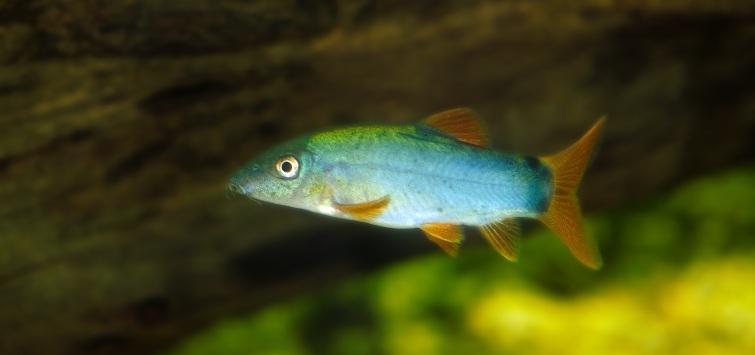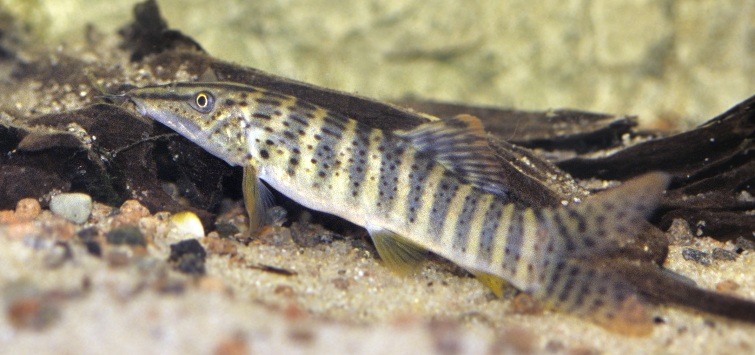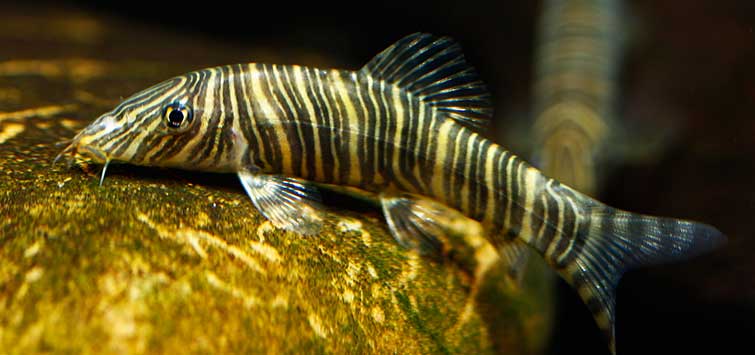Lovely Types of Loaches for the Community Tank
Mark Denaro
Once upon a time, scientific names were a bit simpler. A cory cat was in the genus Corydoras, most African cichlids were Haplochromis, and most of our loaches were members of the genus Botia. These big genera were essentially dumping grounds for related species that aren’t truly closely related enough to be in the same genera, and eventually they found themselves split up. The familiar types of loaches, once one big happy genus, are now divided.
The genus Botia has gone through a lot of upheaval, with some species changing scientific name multiple times. We’re going to take a look at some of my favorite types of loaches, and some newer species, as well as looking at where they are now, scientifically.
The approximately 40 species that once called the genus Botia their home have been divided and moved into eight genera. One of these, Parabotia, is rarely seen in the hobby, but the others all contain some popular aquarium species.
Each of these fishes—those remaining in the genus Botia as well as their reclassified cousins—can still be referred to as “botia” (note the lack of italics and capitalization that denote its use as a common name), and they share a similar shape: a relatively flat ventral surface for living on the substrate, along with whisker-like barbels. The length and depth of the body vary by genus, however, ranging from tall and squat to much more elongated.
They are all easy to feed in the aquarium with a high-quality, varied diet that includes frozen and dry foods, the key to long-term success. All botias will eat snails to some extent, and many have been added to tanks for snail control over the years. Just be sure to keep them in small groups (or “pods,” a nod to their dolphin-like shape and playful personalities), as most of them prefer to be with others of their kind and will not do well as single fish in an aquarium.
The Clown Loach

The best-known and most popular of the botias will always be the clown loach, now known as Chromobotia macracanthus. Mention “botia” to almost any hobbyist worldwide, and this is the species they’ll picture in their mind. This unique fish is the only member of its genus. It is one of the freshwater hobby icons, and also one of the most strikingly colored. A happy, healthy specimen is bright orange with black markings and red fins.
They follow the typical botia body shape, but do so in a rather robust way. There is a lot of misinformation about the size they can reach, but that is mostly due to the fish’s tendency to reach much smaller sizes in the aquarium than it does in nature, which is probably a good thing.
Very few individuals will exceed 8 inches (20 cm) in an aquarium, yet I’ve seen photographs of 24-inch (60 cm) animals collected in the wild. One picture that I’ll always remember was a guy I knew in Indonesia with his hand in an aquarium with a large clown loach. With his fingers extended and touching the bottom of the tank for comparison, the fish was so deep that its back was at his wrist, making it approximately 8 inches (20 cm) tall, or the length most large specimens reach in an aquarium. This was height, not length!
This is a peaceful, gregarious species that will hide during the day when initially added to the tank. They eventually overcome that behavior and will be active during the day. They can be mixed with pretty much any fish that won’t pick on them and can be kept in planted aquariums as long as the hobbyist is willing to do some replanting, since they like to root around in the substrate and can dislodge plants in the process.
This behavior will tell you that, as with all of the botias, soft substrates are preferred. Clown loaches have the amusing habit of “sleeping” on their sides, or even upside-down. Many an aquarist has thought their new fish were dead, only to have them turn upright and swim away when they try to remove them.
Enjoying TFH Magazine? Subscribe Today!
True Botia Loaches
Fish that are still in the genus Botia include some old favorites plus cool fish that are newer to science and the hobby. Their body depth is substantially less than that of the clown loach, but not nearly as worm-like as some of the other groups.
Both Botia almorhae and B. lohachata are sold as yoyo loaches, and they are old favorites. Variable in color pattern, it can be difficult to differentiate the two, especially when young. They both grow to about 6 inches (15 cm), and they can get a bit territorial or aggressive as they age.
B. dario and B. striata have never been common in the hobby, which is a real shame. Both hail from India, whose fish still reach the United States inconsistently and in small numbers. B. striata, known as the zebra loach, is one of my favorite members of the group, with its very appealing striped pattern.
Newer additions to the hobby include the angelicus botia or Burmese border loach (B. kubotai), and the emperor loach (B. udomritthiruji), both of which hail from Myanmar. These two are a bit more worm-like in shape than the Indian members of the genus, and both are attractive, with patterns of stripes and spots.
Sinibotia & Leptobotia Loaches
Members of the genus Sinibotia are slightly larger, generally reaching 4 to 8 inches (10 to 20 cm) in length. Their body shape is rather elongated. Most feature patterns of dark vertical stripes ranging from brown to black on lighter bodies of a cream to brassy gold color. Their slenderness allows them to get into narrow crevices between rocks and roots.
My favorite in this group is the golden Chinese loach (Sinibotia superciliaris), which is occasionally available in the trade and is to my eye the most beautiful of this group. The variable vertical bars are a rich chocolate hue, and the body color is a beautiful yellow/brass/gold that is unique to this species. It is one of the larger ones. It works well in larger community aquariums, preferably at least 6 feet long (at least 180 cm), that house larger, peaceful fish.
Leptobotia species feature a rather unusual body shape. From the head to the dorsal, they look like a fairly typical botia, but from the dorsal fin to the tail, they are slender and elongated.
The genus runs the gamut in size, from small to large. None of the species are common in the hobby, but several are available at least occasionally. Of these, the one you’re most likely to encounter is the largest member of the genus, Leptobotia elongata, which has several common names, including royal clown loach, imperial flower loach, and elongate loach.
It’s not unusual to find this fish available in the range of 6 to 12 inches (15 to 30 cm), making it suitable only for large aquariums. But it will eventually reach a size of 20 inches (50 cm) when full grown, and it is capable of outgrowing even very large tanks.
This fish is somewhat of an exception to the body shape mentioned above, as it’s almost cigar shaped. Most of the Leptobotia loaches hail from China and will tolerate cooler water. Indeed, most will appreciate a season of cool water throughout the year. L. elongata sees temperatures in nature that range from 40° to 84°F (5° to 29°C).
Yasuhikotakia Loaches

Several of the commonly available botias have been moved to the genus Yasuhikotakia. This is one of the two more territorial or aggressive groups. We’ve known several of these for a long time, though there are some newcomers here as well.
The second-most popular of this group is probably the blue botia (Yasuhikotakia modesta). In my early days in the hobby, we mistakenly considered this to be two species due to the existence of two different color patterns, one with red fins and one with yellow fins. The yellow-finned fish were sold as Botia modesta and the red-finned as B. rubripinnis.
Both varieties were regularly available and were usually offered by most wholesalers. Since they’re not as colorful, the yellow-finned form is only occasionally available today.
The really unfortunate thing is that the blue loach became one of the most frequently to be offered as dyed fish in the trade. Most often they are dyed blue, but also purple and other colors. The wild form is an attractive blue, but the dyed fish are much more brightly colored.
The dyeing process is, however, something no fish should ever be put through. Practices such as this should never be supported by purchasing the fish. Any dyed, painted, or tattooed fish should be avoided at all costs. Not buying them is the only message that those who engage in these practices will understand, and the only way to stop them.
Yasuhikotakia loaches are accustomed to living in a group, but there is always a fair amount of aggression, and a dominance hierarchy will be formed. Take care to ensure the well-being of the lowest-ranking individuals. Give them plenty of places to hide, and only keep them with the most robust tankmates.
For example, I’ve had good experiences when keeping them with mbuna, but not so much with slower-moving, less-aggressive fish, such as angels, discus, or gouramis. They are all active and need a larger aquarium than you might think based solely on their size. A 4-foot (120-cm) tank is really the minimum, even for small species such as the skunk loach (Y. morleti).
Tiger Loaches

The group that always stood out in the genus Botia for its more pointed head and high level of aggression are now members of the genus Syncrossus, collectively known as tiger loaches. While a number of them have been available consistently in the hobby, they’ve never become truly popular due to their temperament.
I’ve always found S. berdmorei, one of the tiger loaches, to be quite attractive. The pectoral, ventral, and anal fins of this species can be yellow or red, and it is sometimes called the redfin or yellowfin tiger loach.
The head is spotted, and the body has a pattern of vertical stripes. They can reach up to 10 inches (25 cm), though 6 inches (15 cm) is more common in the aquarium. They won’t hesitate to extend their dominance over any tankmates. They can be kept in a group, but expect a high level of intraspecies aggression. Be sure they have plenty of hiding places and can get out of each other’s line of sight.
Over the years, I’ve found the best tankmates to be mbuna and other aggressive fish capable of fast movement. Upper-water schooling fish, like danios, Congo tetras, Chalceus, and the like also work quite well.
Pygmy Loaches
The best of the new genera from an aquarium standpoint is undoubtedly Ambastaia, which includes the dwarf or pygmy species. While the black-lined loach (Ambastaia nigrolineata) is attractive, with its dark longitudinal stripes on a light body, the real jewel is A. sidthimunki, the dwarf botia, or dwarf chain loach, which features a checkerboard pattern.
They are peaceful, schooling, and diurnal, making them well suited to aquarium life. Like most of the types of loaches covered here, they will be most comfortable when kept in a group, where little intraspecific aggression will be displayed.
They have both been available in waves over the years. Fortunately, A. sidthimunki is being regularly exported from Thailand at the moment.
If you have a community aquarium, I’d encourage you to add this species. They’re enjoyable to watch, attractive, and will help to keep any unwanted snails in check. They do particularly well in a planted tank, where they will find places to hide in and among the plants and hardscape.
A Lovely Loach for Every Taste
We all knew that Botia was too broad a genus as it once stood. It seemed inevitable that it would eventually be broken down, and the fact that it happened is a good thing for aquarists. It makes it easier to generalize the requirements and habits of each group and provide guidance for keeping them.
Whether you’re attracted to one of the oldies but goodies of the hobby, or intrigued by one of the newer species, there is something to be recommended in all of them. As long as you can meet their needs—most of which include being kept in small groups of at least five—and your setup will help them to thrive, they all make interesting aquarium inhabitants. After doing your research, maybe you’ll want to include a pod of pretty and playful botia loaches to your existing setup, or plan to include a small group of them in your next tank.




